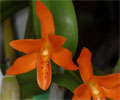|
|
|
|
|
| |
Established Seedlings of
Cattleya aurantiaca 'Shorty' × self |
|
| |
|
|
| |
| Number: |
TN8430 |
| Name: |
Cattleya aurantiaca 'Shorty' × self
|
| Type: |
self (What's that?) |
|
Click to Enlarge

Pod Parent Flower |
Click to Enlarge

Pod Parent Plant, 1-inch wide tag |
|
|
|
| |
Comments: The parent plant is only a few inches tall, making it the perfect choice for people who have avoided "standard" sized Cattleya aurantiaca because of their extreme height. We don't know if the offspring will also be short, but there is a good chance.
Parent plant: One of the offspring from our TN5579 effort of 2006. Unusually small stature for the species.
For additional origin/habitat information supplied courtesy of
Charles and Margaret Baker, see further below, near the bottom of this page.
|
Temperatures we attempt to use in the lab & greenhouse:
| For Species: |
|
Spring, Summer, Autumn, Winter: days average 80°F, nights 58°F; best fit is cool-intermediate 75-58°F
(Source:
Baker's Web OSC) |
| For Genus: |
|
Spring, Summer, Autumn, Winter: days average 83°F, nights 60°F; best fit is Intermediate 83-60°F
(
) |
|
About the name...
| Etymology of |
aurantiaca |
|
From Latin "aurantiacus" dead gold, yellow-orange.
(Source:
Mayr & Schmucker 1998) |
| Etymology of |
Cattleya |
|
Named in honor of William Cattley, English horticulturist in the 19th century.
(Source:
Pridgeon 1992) |
| Pronunciation of |
aurantiaca |
|
aw-ran-tee-AH-ka
(Source:
Hawkes 1978) |
| Pronunciation of |
Cattleya |
|
KAT-lee-ya
(Sources:
Pridgeon 1992, Hawkes 1978) |
|
If you would like to direct someone to this web page, please copy and paste this URL into your email:
http://troymeyers.com/d?128430
|
ESTABLISHED SEEDLINGS
of these are not currently available, but we have some maturing in the greenhouse and expect to offer them in the future.
There are 7 items with
1 plant per
item that will be considered for sale later.
Click here to see if we have flasks available.
|
|
|
| |
The origin/habitat information below is supplied courtesy of Charles and Margaret Baker
The following information is based on the name of the plant provided by the donor, and assumes that the name is correct. If the plant has been misidentified, then the following information may not be correct.
This text is copyrighted by the Bakers and may not be reproduced without permission.
ORIGIN/HABITAT: Mexico, Guatemala, El Salvador, Honduras, and Nicaragua.
In Nicaragua, plants grow on trees in dry hilly pastures and in roadside
forests. Near Matagalpa and Managua they have been found at 1950-3300 ft.
(600-1000 m). In Mexico, plants grow on trees on protected hillsides and
in stream-valleys at 1000-3600 ft. (300-1100 m) on Pacific-facing slopes.
The habitat extends from the State of Sinaloa southward to the border with
Guatemala. Plants are also reported on the Revillagigedo Islands, which
are located about 450 mi. (725 km) off the coast of the State of Colima.
More about this information and the Bakers...
|
|
|
| |
|
|
|